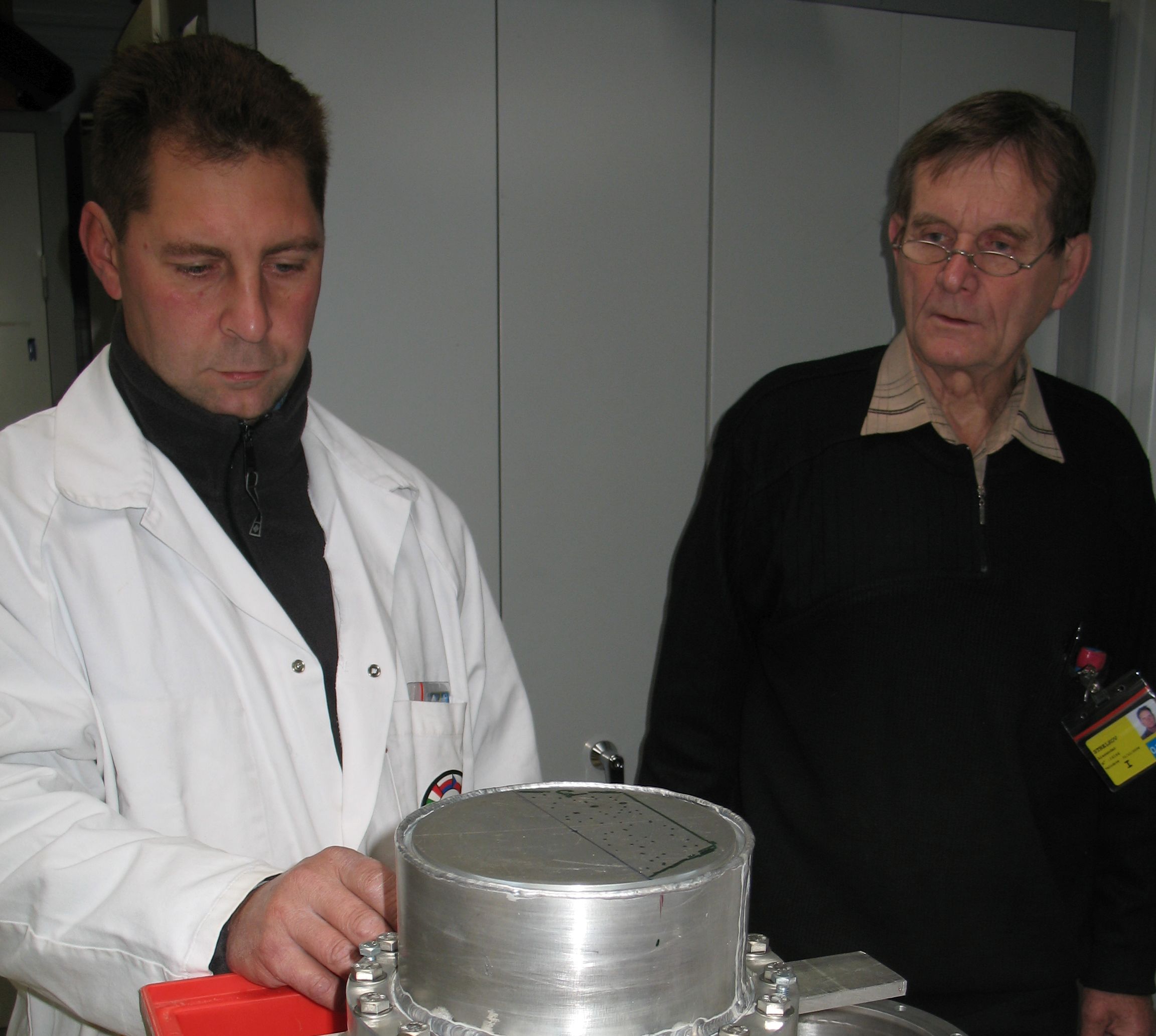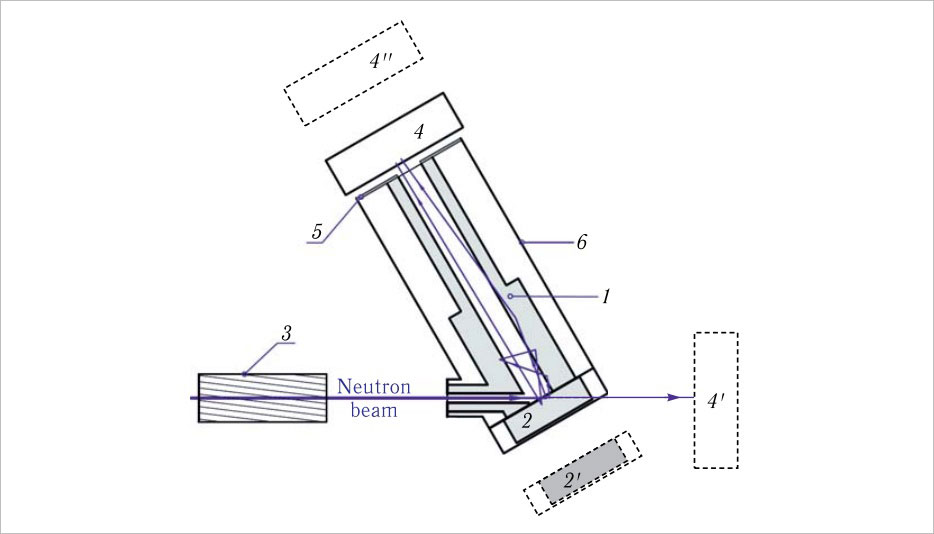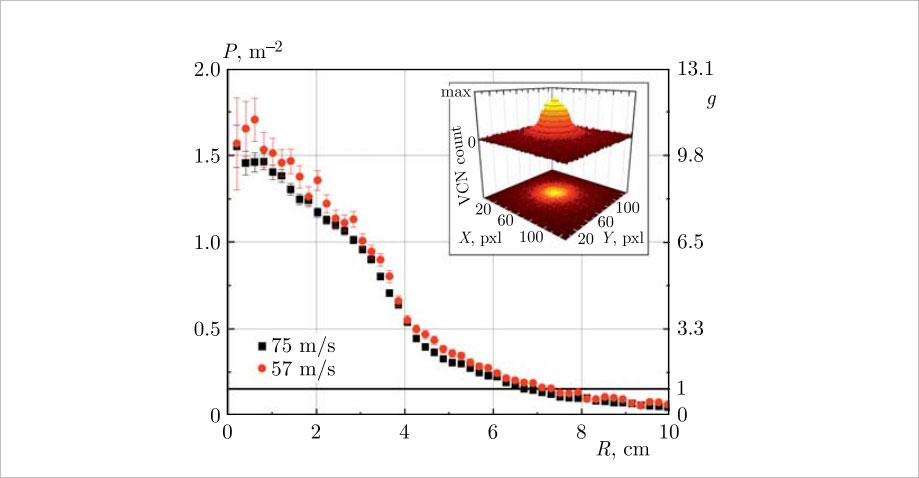Reflector of very cold neutrons increased their extraction tenfold
News, 05 July 2022
Scientists of FLNP JINR as members of an international collaboration have conducted research on the enhanced directional extraction of very cold neutrons (VCNs) using a diamond nanoparticle powder reflector. This reflector offers big prospects for fundamental science, since it makes it possible to increase the flux of very cold neutrons at research facilities by several times.
About 15 years ago, scientists of the Institute Laue-Langevin (ILL) in collaboration with FLNP researchers created and began studying reflectors of very cold neutrons based on Detonation NanoDiamond (DND) powders. Since then, numerous diverse studies dedicated to reflectors have been conducted world-wide.
 Participants of study: scientists of Sector of Investigations of Neutron Fundamental Properties of FLNP JINR, senior researcher Alexey Muzychka (on the left) and leading researcher Alexander Strelkov (on the right)
Participants of study: scientists of Sector of Investigations of Neutron Fundamental Properties of FLNP JINR, senior researcher Alexey Muzychka (on the left) and leading researcher Alexander Strelkov (on the right)
In particular, a collaboration of scientists, including researchers of FLNP JINR, the Institute of Chemistry of Clermont-Ferrand (Aubières, France), the Institute Laue-Langevin (Grenoble, France), and the National Research Centre “Kurchatov Institute” (Moscow, Russia), have measured the enhanced directional extraction of VCNs from a neutron source using a diamond nanoparticle powder reflector (F-DND – Fluorinated Detonation NanoDiamond). The study has demonstrated that nanodiamond crystals produced by them make it possible to increase the directional neutron extraction and accordingly the intensity of very cold neutron sources tenfold and more.
Without such a reflector, the percentage of neutron extraction from the source was tenths of a percent. The reflector has made it possible to increase this figure by an order of magnitude – up to several percent. Such a nanoparticle reflector works for VCNs and CNs (cold neutrons), since their wavelength is comparable to the size of a nanoparticle.
JINR scientists have designed and created the reflector. However, measurements have been carried out at the VCN beam of the PF2 facility of the ILL reactor (Grenoble, France).
The reflector has a form of a thick-walled cylindrical tube closed at one end with an inner cavity diameter of 3 cm and a height of 30 cm. Such a “glass” has inner walls and a bottom made of magnesium foil with a thickness of 50 µm, which covers a layer of diamond nanoparticle powder. The foil is an essential component that holds nanopowder. It is impossible to use glue in this case, since any binder consists of elements capable of capturing neutrons very well. Magnesium has a small capture cross section, and neutron losses on it are small. Unlike aluminium foil, for example, which captures more neutrons than magnesium one.
A collimated VCN beam, passing through a velocity selector and a small hole in the side wall, falls to the centre of a disk at an angle of 60° to the cylinder axis. Elastically reflected from the layer of nanodiamonds in the disk, VCNs spread along the cylindrical tube, reflecting from the nanoparticle layer, which forms its sidewall. In the result of multiple reflections from inner walls of the cylindrical tube, VCNs could be directed along its axis and extracted through its open end. Such neutrons are detected by a positive-sensitive detector (PSD) perpendicularly placed to the cavity axis and moved to different distances from the cavity exit. An exit diaphragm made of cadmium is installed at the end of the cylindrical tube from the detector side. It makes VCNs get into the detector only through the exit hole of the cavity (through the F-DND powder). The whole reflector is located in a vacuum volume pumped to the level of 0.1 mbar, which has neutron entrance and exit windows made of thin (100 µm) aluminium foil. A velocity selector with screw slits was used in the experiment. The selector has the neutron velocity resolution of about 20%. The spectra of neutron velocities transmitted by the selector at different rotation frequencies have been measured by the time-of-flight method.
 Fig. 1. Measurement scheme. 1 – cylindrical tube from reflector; 2 – reflector in form of disk; 2’ – disk position during measurement of neutron flux in the incident beam; 3 – velocity selector in form of rotating drum with screw slits; 4 – positive-sensitive detector (PSD) for measuring flux of outgoing neutrons; 4’ – position of PSD at changing of neutron flux in incident beam; 4’’ – position of PSD at changing of the angle distribution of outgoing neutrons; 5 Cd-diaphragm; 6 – vacuum volume
Fig. 1. Measurement scheme. 1 – cylindrical tube from reflector; 2 – reflector in form of disk; 2’ – disk position during measurement of neutron flux in the incident beam; 3 – velocity selector in form of rotating drum with screw slits; 4 – positive-sensitive detector (PSD) for measuring flux of outgoing neutrons; 4’ – position of PSD at changing of neutron flux in incident beam; 4’’ – position of PSD at changing of the angle distribution of outgoing neutrons; 5 Cd-diaphragm; 6 – vacuum volume
Specialists used the term “gain” to evaluate the results. It shows how many times the directional neutron flux has increased.
The number of neutrons extracted in the specific direction without the reflector was taken as a unit. Researchers conditionally divided neutrons emitted from the VCN source into those directed along or very close to the axis of the reflector and those emitted at rather large angles. For the first neutron group, the gain factor was from nine to ten, for the second one it was several dozen (up to 33), depending on the neutron velocity.
“With respect to the flux from an isotropic source located at the bottom of the reflector cavity, the gain in the VCN flux density along the beam axis is about 10 for the neutron velocities of 57 m/s and 75 m/s. The gain in the total flux at the exit from the reflector cavity is 14 for the fastest VCNs for the interval 46—92 m/s, and it increases with decreasing VCN velocity, reaching 33 for the slowest VCNs,” a co-author of the study, a senior researcher of the FLNP JINR Sector of Investigations of Neutron Fundamental Properties Alexey Yurievich Muzychka said.
 Fig. 2. Dependence of VCN flux density P detected by PSD placed at a distance of 42 cm from the exit diaphragm, from distance to axis of the cylindrical cavity R (left axis). Round dots correspond to neutron velocity of ∼ 57 m/s, square dots correspond to neutron velocity of ∼ 75 m/s. The right axis is the gain factor g in flux density with respect to density of flux from homogeneous isotropic source located at the cavity bottom. The inset indicates the map of intensity of PSD count by pixels in measurements at velocity of ∼ 75 m/s
Fig. 2. Dependence of VCN flux density P detected by PSD placed at a distance of 42 cm from the exit diaphragm, from distance to axis of the cylindrical cavity R (left axis). Round dots correspond to neutron velocity of ∼ 57 m/s, square dots correspond to neutron velocity of ∼ 75 m/s. The right axis is the gain factor g in flux density with respect to density of flux from homogeneous isotropic source located at the cavity bottom. The inset indicates the map of intensity of PSD count by pixels in measurements at velocity of ∼ 75 m/s
There is a financial advantage as well. “You have a reactor, which is a neutron source. With such a reflector in the source, it is like you have ten reactors at the same time,” the scientist explained.
The use of the reflector in sources of VCNs significantly increases the flux of VCNs at research facilities, which makes it possible to extend the application of VCNs both in fundamental research (search for the electric dipole moment of a neutron, neutron-antineutron oscillations, new types of interactions, measurement of the neutron lifetime) and neutron scattering (spin echo, reflectometry, tomography). However, it is not possible to use it in applied research in the near future. For this purpose, the intensity of existing sources should be increased by tens or even hundreds of times.
In FLNP, scientists are conducting further research on the creation of even more advanced reflectors of VCNs and CNs from diamond nanopowder. It turned out that nanodiamonds produced for the experiment were not the most effective ones. “This powder was prepared using usual method during an explosion in special detonation chambers. As a result, agglomerates are very tightly stuck together and do not allow powder to be dense enough. The denser the powder is the smaller path a neutron has to go through the powder to reflect. For small radii considered here, it is a very important characteristic,” Alexey Muzychka said.
He added that a group of scientists had conducted further experiments, which showed the possibility of creating reflectors that are more efficient. At the same time, it is possible to select the most efficient size of nanocrystals for each neutron velocity. The shorter the wavelength is (and accordingly the higher the neutron velocity, since the wavelength is inversely proportional to the neutron velocity) the smaller particles are needed.
“Since then, a number of important steps have been taken. We saw that the main factor holding the reflectivity is the presence of hydrogen on the nanopowder surface. We learned how to process the powder in a certain way replacing hydrogen with fluorine, which is not dangerous element in terms of neutron losses. Thus, we increased albedo, the possibility of neutron reflection. Later, we made the powder smaller and learned how to deaglomerate it. We studied the elemental composition of powder. It turned out that in addition to hydrogen, there were many other impurities causing neutron losses. We learned to partially fight against them. We have not created a perfect nanodiamond powder yet, but we are moving in this direction,” the expert said.
Moreover, a program aimed at calculating the transport of VCNs in powder has been developed in FLNP. In the future, a group of scientists is going to carry out experiments with reflectors at the IBR-2 and the NEPTUN, the fourth-generation neutron source being developed at JINR.
More details in the JINR preprint http://www1.jinr.ru/Preprints/2022/13(P3-2022-13).pdf